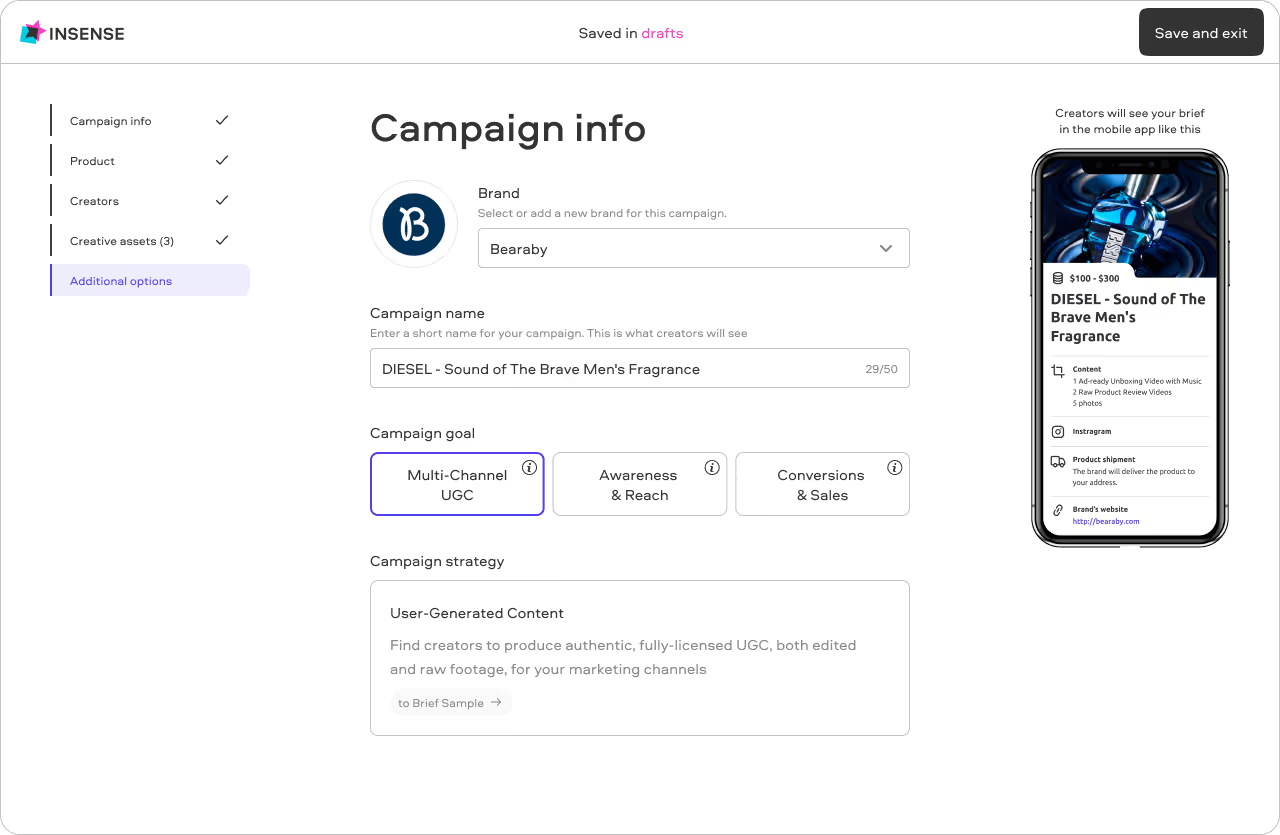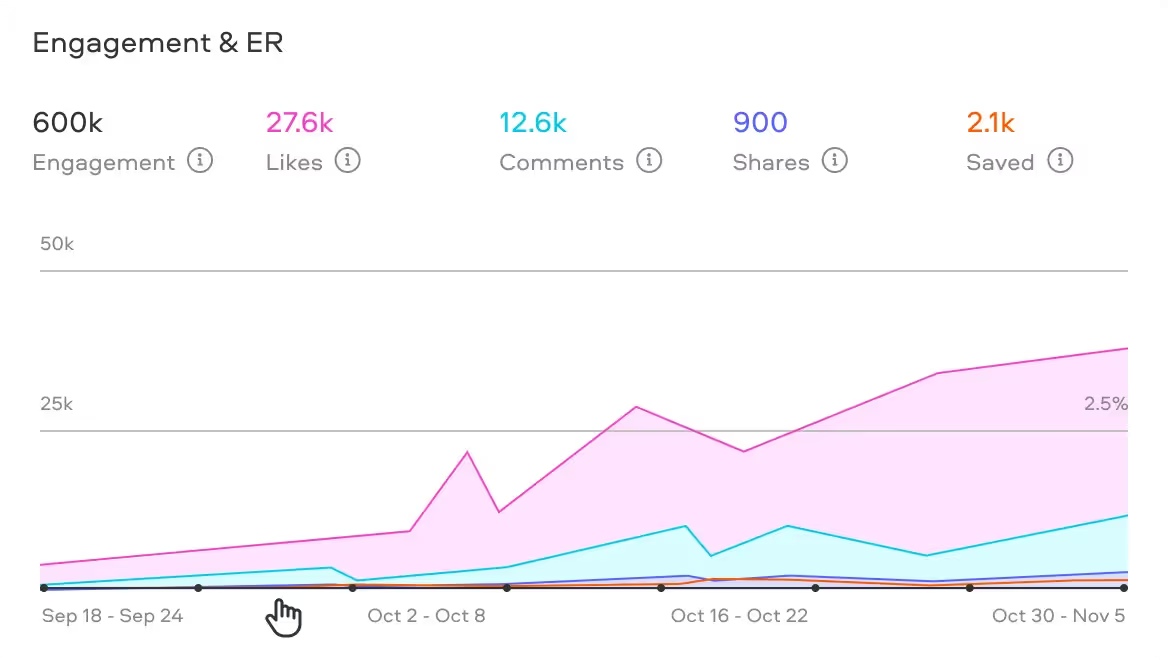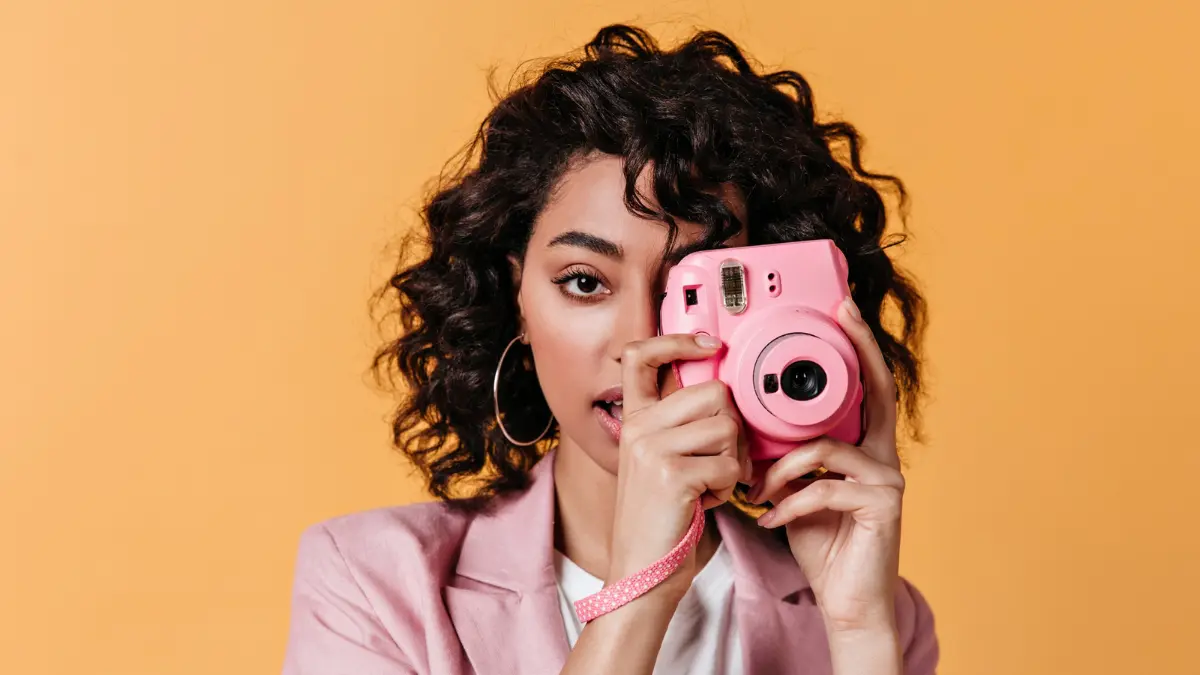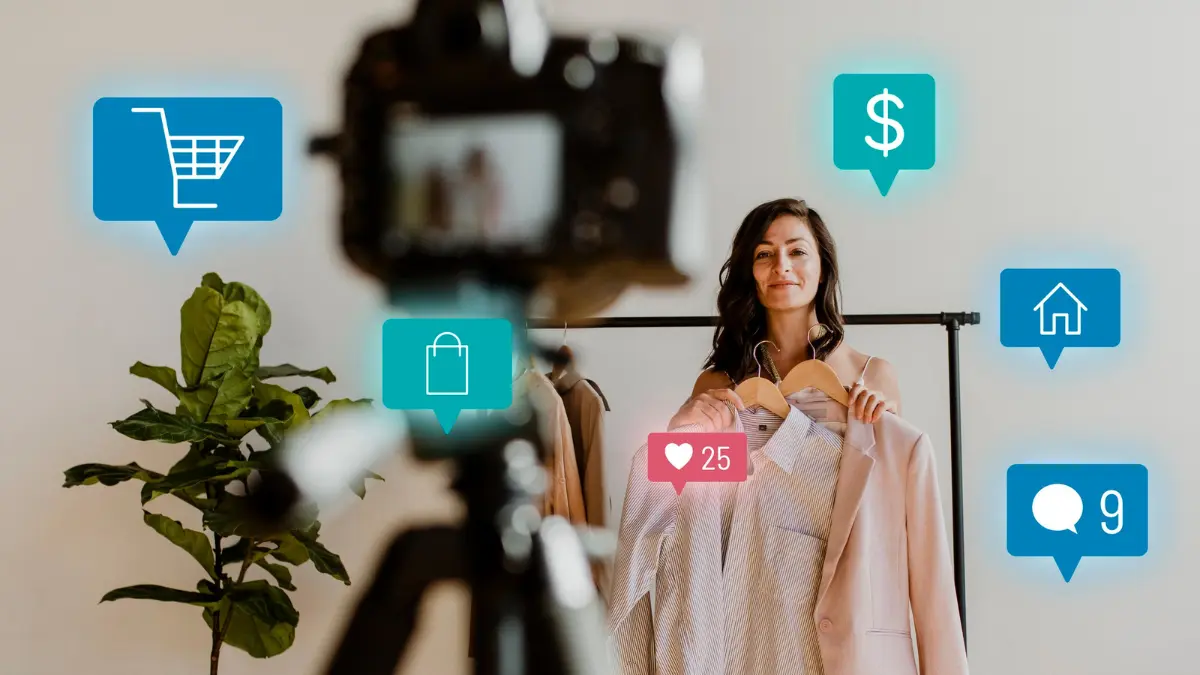Big ideas are great. We’re all about big ideas. But without a clear plan, they stay exactly that – ideas.
A creative strategy takes those brilliant but half-baked concepts on your office whiteboard and turns them into real-life, well-performing campaigns. Why? Because you’ve got a clear blueprint that reminds you who you’re talking to, what you want to say, and how to measure success.
If you skip this step (and many brands do 👀), you’ll end up with a mishmash of content that might look good but never really hits the mark.
Here, we explore what a creative strategy is and how you can build one in 8 simple steps.
What Is Creative Strategy?
A creative strategy is just a game plan for how you’re going to tell your brand’s story and hit your marketing goals.
In the context of influencer marketing, creative strategies should also cover how you find and work with the right people.
Mostly this will involve two avenues:
- Databases (a.k.a. giant contact lists). Yes, you can scroll through an endless list of names, but you often have to do the heavy lifting to figure out who’s a good fit.
- Search tools. These let you filter by audience, engagement, niche, or platform so you can quickly discover creators who align with your campaign goals.
Why Creative Strategy Matters
The word “strategy” can feel a bit overwhelming, but there’s a reason you should care about having one – especially when it comes to your influencer marketing strategy.
- It helps you marry up your message and goals. Because you’ve got a clear blueprint in place, every campaign can be mapped back to the results you actually want.
- It keeps your brand consistent. Working with multiple creators can get messy fast if you don’t have a clear plan. A strategy makes sure your tone, visuals, and messaging feel like you, even when the content is showing up in someone else’s feed.
- It helps you test and improve. When you have a clear strategy in place, you can learn from what’s working and what’s not. This will ultimately help you improve every future campaign.
The Creative Strategy Framework
Your creative strategy is a living framework that gives your influencer campaigns structure. It’s there so you know what you want to achieve, what kind of content you should create, and the types of creators that will help you get there.
It also means you’re not winging it every time you brief a creator or launch a collab (a huge bonus).
Let’s break the creative strategy process down step by step.
1. Research and Insight
Start by grounding your ideas in reality (pie in the sky thinking is fun, but good campaigns are rooted in data).
Dig into past campaign data, look at what actually worked (and what flopped), and listen to what your customers are telling you in reviews, comments, and DMs. Pair that with trend signals, like what formats are blowing up on TikTok, which hashtags are gaining traction, what conversations your audience is having.
Here’s how you can do this:
Mine your owned data
- Check your top 10 posts and ads by engagement rate, watch time, CTR, saves, and cost per result. Note the hook, length, format, creator type, and CTA in each one.
- Use GA4 and your ecom backend to find landing/product pages with the highest conversion rates from social.
- Use Google Search Console to find queries that are already bringing traffic. You can use the wording your audience uses and feed them into hooks and captions.
Get the customer’s voice
- Run post-purchase surveys to find out why people bought or what hesitations they had.
- Tap customer support transcripts to find patterns in complaints.
- Check out reviews and user generated content (UGC) comments (yours and competitors) so you can copy the exact phrases customers use.
- Run quick micro-polls on Instagram Stories to ask about use cases, shade/flavor/size preference, or price sensitivity.
Use platform-native insights
- Pull audience demographics and active hours from TikTok, Instagram, and YouTube.
- Scan TikTok Creative Center and IG Reels trends to spot repeatable formats.
- Explore popular hashtags or type your category into the search bar to see autocomplete prompts.
- Get intel from creators, including their audience insights and best historic posts.
Map the competitive and category landscape
- Scour the Meta Ad Library and TikTok Ads Library for popular examples and reverse engineer them.
- Look for objections and questions on forums like Reddit and Quora.
💡Tip: Use your research to create centralized docs your whole team can use. That might be a one-pager that explains what consistently works, or a “voice of customer bank” that highlights quotes, themes, and hook angles you can test.
2. Ideation and Brainstorming
This is your messy whiteboard stage.
Start wide by sketching out all possible themes, hooks, and story angles. Think it’s relevant? Get it down on paper.
Here are some examples for inspiration:
- Behind-the-scenes/GRWM. Show a creator integrating your product into their morning or workday routine.
- Before/after transformations. Works especially well for beauty, wellness, home, or fitness.
- Hot take reels. Quick, punchy videos where a creator shares an opinion that goes against the grain (“Why drugstore skincare beats luxury every time”).
- Micro-challenges. “I swapped my [X] for [your product] for 7 days—here’s what happened.”
- Trend remixes. Pair your product with trending sounds or formats to meet your audience where they already are.
If you’re stuck, lean on idea frameworks:
- Highlight the frustration, then show how your product fixes it.
- Call out a common misconception and flip it on its head.
- Show how your product fits into daily life.
- Focus on the end result your audience wants.
This is where the research you did in the previous stage pays off. You can map ideas against your audience’s pain points, desires, and language. So, if your customers fret about sustainability, brainstorm eco-friendly angles.
💡Tip: bring in your team and a few trusted creators to help. Influencers often have the best read on what will resonate because they know their audience’s triggers and humor.
Once you’ve got a long list of raw ideas, filter them through the lens of your brand goals. Keep the ideas that hit your goals and match your audience insights – you can bin the rest or save them for later.
3. Craft Your Big Idea
Now boil it down. Write one crystal-clear sentence that ties together your goal, your audience, and your tone.
Example: “We want Gen Z skincare lovers on TikTok to see us as the fun, no-BS alternative to luxury brands by showing real UGC transformations.”
That sentence becomes your north star, and every caption, visual, and collab should ladder back to it.
So how do you come up with your own sentence like that?
- Start with your goal: What’s the single most important thing you want this campaign to achieve? Awareness, engagement, conversions, community growth? Write that down. E.g. “Drive more traffic to our TikTok shop.”
- Add your audience: Who are you talking to, and what do they care about? Get specific (“Gen Z skincare lovers” says more than “women 18–34”). E.g. “Gen Z skincare lovers who hate overhyped luxury products.”
- Layer in your tone and personality: What vibe do you want to show up with? Friendly? Bold? Reassuring? Playful? E.g. “Fun, no-BS, and rooted in real transformations.”
- Combine into a one-liner: Merge the three pieces into one tight sentence. E.g. “We want Gen Z skincare lovers on TikTok to see us as the fun, no-BS alternative to luxury brands by showing real UGC transformations.”
💡Tip: If you struggle to get it down to one sentence, it’s probably still too vague. Keep trimming until it feels punchy and memorable.
4. Set Metrics and KPIs
Your success metrics are key performance indicators (KPIs) that show the progress of your campaign, and they’ll depend on your goals and the kind of campaign you want to run.
Resist the temptation to track everything.
Instead, choose 2–3 success metrics that tell you whether your campaign is working. If your goal is awareness, track reach and impressions. If it’s sales, look at conversions and referral traffic. If it’s engagement, measure saves, comments, and shares.
As an example, if your goal is to increase your website visitors by running a campaign on Instagram, your KPIs might be the number of profile visits you have from each campaign post and how many people click the link in your Instagram bio.
If your goal is awareness, track:
- Reach and impressions
- Video views and watch time
If your goal is engagement or community, track:
- Comments and saves
- Shares
If your goal is traffic or sales, track:
- Click-through rate (CTR)
- Referral traffic from social or creators through UTM links
- Conversions and revenue generated
5. Define Your Audience
Your target audience is simply the kind of individuals who would buy your products – but you need to go deeper than “women aged 18–35.”
Who are they really? What’s their lifestyle? What keeps them scrolling at 11pm?
Build that picture so you can brief influencers properly and give them the context they need.
Here are a few ways you can find out more about your audience:
- Look at platform analytics. TikTok, Instagram, and YouTube all give you basic demographic and behavioral data.
- Check audience overlaps in creator data. When you’re shortlisting influencers, ask for their audience insights.
- Mine reviews, comments, and DMs. Customers often drop nuggets about how they use your product in their daily life, what else they’re into, or what frustrations they have.
- Use surveys and polls. Quick Instagram Stories polls or email surveys can reveal more about your audience.
- Hang out where they do online. Subreddits, Discord groups, niche Facebook communities, even TikTok comment sections are great for finding out more about what makes your audience tick and how they talk.
6. Plan Budget and Timing
Setting a realistic budget will help you check your spending and spot when you might be splashing a bit too much cash.
Factor in creator fees, paid ads, and production costs (like editing, design, or props).
Then map out key dates, like when briefs go out, when content should land, when to launch, and when you’ll review results
Here are the costs a content budget should cover:
- Budget for paid ads: This may differ for various social media platforms. Find out the exact costs or a range you can use.
- Budget for marketing personnel: Payment for members of your team.
- Budget for digital assets: This includes the costs of making a logo, email templates, campaign videos, and even an asset management system.
- Budget for marketing tools: Project management software, analytic tools, scheduling tools, and collaboration tools.
- Budget for the launch of a new product, trade shows, PR, etc.
- Budget for contractors: Influencers, freelance copywriter, designers.
7. Execute and Collaborate
This is where it all starts to come together.
Now you know your goals, target audience, and budget, you can start looking for the right influencers to work with.
Use Insense’s Creator Marketplace to filter by audience demographics, niche, engagement rates, and location so you’re connecting with people who actually match your campaign goals.

💡Tip: Don’t just look at follower count. Engagement quality, content style, and audience trust matter way more. A nano-influencer with 5k diehard fans can often drive more sales than a big account with lukewarm engagement.
Once you’ve chosen your creators, brief them well.
Your brief should cover:
- Campaign goals (awareness, conversions, UGC for ads, etc.)
- Audience insights (who you’re targeting and what matters to them)
- Deliverables (content formats, length, number of posts)
- Brand guidelines (tone, dos/don’ts, mandatory tags or disclaimers)
- Timeline (deadlines for drafts, revisions, and launch)
- Payment terms (so there’s no confusion later)
Use Insense’s creative brief template to make sure everyone’s on the same page about deliverables and deadlines.

8. Test and Optimize
The real power of a creative strategy is that it gives you a repeatable way to learn from and improve your campaigns. But that only happens if you test and optimize on a regular basis.
As well as keeping track of your chosen success metrics (see point above), run A/B tests to see which elements perform better.
You might test different:
- Hooks
- CTAs
- Formats
- Lengths
- Visuals
- Influencers
💡Tip: Use Insense’s Performance dashboard to track metrics by creator, content format, and hook type. Or, if you’re using your own stack, pull data from platform insights (Instagram, TikTok, YouTube) and layer it into a simple tracking sheet.

Creative Strategy Examples
Here’s how this framework plays out in different industries.
We’ve used hypothetical ad creative strategy examples here, but you can follow a similar formula if you’re doing this yourself.
Ecommerce Brand
- Research and insight. Past campaign data showed unboxings and “before/after” skincare content drove the most conversions.
- Ideation and brainstorming. The team sketched influencer generated content (IGC) themes like GRWM routines and transformation reels.
- The big idea. “We want Gen Z women on TikTok to see us as the fun, cruelty-free alternative to big beauty brands.”
- Metrics and KPIs. Engagement (saves, shares) and TikTok shop visits.
- The audience. Young women, 20–30, eco-conscious and skeptical of luxury beauty hype.
- Budget and timing. $20k for creator fees, $10k for ads; three-month campaign.
- Collaboration. Partnered with 15 micro-influencers through Insense, using clear briefs and UGC-style content.
- Test and optimize: A/B tested ad creative strategies and “routine” vs. “before/after” content. Found transformations performed 2x better and became the core focus.
Mobile App Launch
- Research and insight. Early feedback showed users didn’t understand how the app fit into their daily workflow.
- Ideation and brainstorming. Brainstormed story angles like “day in the life using the app” and “common mistakes the app solves.”
- The big idea. “We want busy millennials to see our app as the go-to tool that makes everyday tasks easier, faster, and more fun.”
- Metrics and KPIs. App installs, CTR to app store, and 30-day retention.
- Audience. Millennials juggling work, fitness, and personal projects, always looking for convenience hacks.
- Budget and timing. $50k total: 60% creator fees, 30% paid ads, 10% content editing. Launch timeline: 8 weeks pre- and post-launch.
- Collaboration. Recruited creators to make 30-second demo tutorials, then boosted the best ones with paid ads.
- Test and optimize. Tested tutorial vs. lifestyle integrations. Lifestyle angles got more installs, but tutorials kept users engaged longer.
Digital Services Campaign
- Research and insight. Competitive analysis showed most marketing agencies led with features, not benefits.
- Ideation and brainstorming. Brainstormed content around myth-busting, quick demos, and creator-led case studies.
- The big idea: “We want small business owners to trust our service as the easiest, most reliable way to promote their content.”
- Metrics and KPIs. Leads generated, referral traffic from influencer campaigns.
- Audience. Ecommerce marketers that are struggling to stay on top of their content efforts.
- Budget and timing: $30k for a 10-week campaign, with a mix of creators and retargeting ads.
- Collaboration. Partnered with niche creators on LinkedIn and YouTube who walked through real-world use cases.
- Test and optimize. Compared short-form reels vs. long-form YouTube explainers. YouTube drove more sign-ups, but reels amplified reach.
How Insense Supports Your Creative Strategy
Once you’ve pinned down your creative direction, it’s time to turn those ideas into scroll-stopping content. That’s where Insense makes life a whole lot easier. Here’s how it can quickly become an invaluable part of your creative strategy.
Start with a clear creative brief
Build a detailed brief inside Insense that gives creators exactly what they need to produce usable content.
You can outline things like:
- Your core message, product benefits, and tone
- The hooks you want tested (e.g. problem-solution, POV, unboxing, testimonials)
- Must-have shots like B-roll, demo clips, close-ups, lifestyle scenes
- Key talking points or claims
- Required CTAs and formats (TikTok/Reels versions, 9:16 vs square)
Creators submit concepts before they shoot so you can catch any mismatches early.
Get modular UGC instead of one-off videos
Sure, having a polished, final video is great, but if you want to reuse and repurpose content across channels and campaigns, it really helps to have modular UGC.
This means creators deliver (at your request):
- Multiple hooks
- Multiple CTAs,
- Raw footage and B-roll
- Still images and thumbnail options
- Different scene variations
So, instead of one asset, you get a full content pack you can mix and match without booking a new shot every time you need a fresh angle. This is particularly useful if you’re running paid ads because you can create a steady stream of variables to test.
Find creators based on fit
Insense’s marketplace lets you discover vetted creators who are a good fit for your brand as well as have a decent reach.
You can filter by:
- Product niche
- Audience demographics
- Platform
- Content performance
- Previous campaigns
- Price
Manage rights, approvals, and payments
There’s a lot of admin behind every successful creator workflow, but Insense takes it off your plate. Things like:
- Content approvals happen inside the platform
- Creators don’t get paid until content is delivered and approved
- Usage rights are handled automatically
- Everything is logged in one place for your team
Want support? Tap Insense’s Creative Concepts and Managed Services
If you don’t have time to build creative direction or manage dozens of creators, Insense can give you an in-house team feel without actually building one.
The Managed Services team can turn your goals into creative concepts and scripts, source and manage creators for you, collect and quality-check content, and edit and package assets for ads. Perfect during growth periods, if you’re launching a new product, or holiday and ad-heavy cycles when you need volume and quality very quickly.
Ready to put your creative strategy into action? Discover the right creators, source modular UGC, and manage everything from briefs to payments in one place. Try Insense today.










